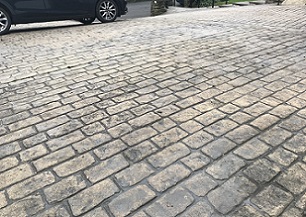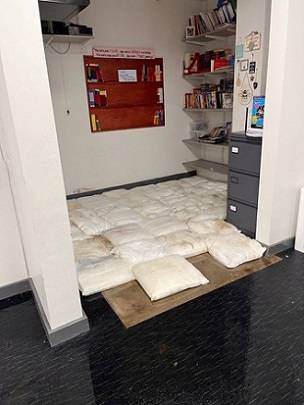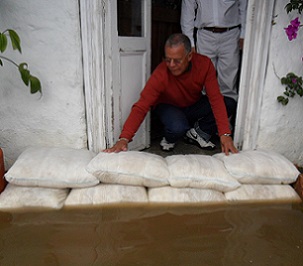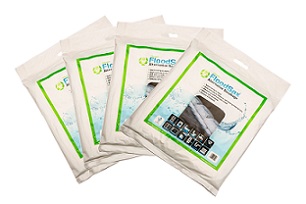 The UK is losing far too many gardens to driveways like this
The UK is losing far too many gardens to driveways like this
 FloodSax can be used to soak up water as they did inside this Yorkshire school
FloodSax can be used to soak up water as they did inside this Yorkshire school
 FloodSax sandless sandbags can also be built into robust anti-flood barriers to keep floodwater out of homes and businesses
FloodSax sandless sandbags can also be built into robust anti-flood barriers to keep floodwater out of homes and businesses
 FloodSax come in space-saving vaccum-wrapped packs so they are very easy to store
FloodSax come in space-saving vaccum-wrapped packs so they are very easy to store
Why urban creep is even creepier than Michael Jackson’s Thriller
It’s known as urban creep, it’s taking over the UK’s cities and towns and once it’s happened it seems there’s no turning back.
Urban creep is the catchy phrase that summarises people turning their gardens into tarmac, concrete or even artificial grass but it’s causing massive flooding problems, horrific insurance claims and incalculable human misery.
Grass and gardens soak up an awful lot of rain – especially when it’s torrential – but when it’s paved over, the water has nowhere to go so it floods homes and businesses. Add to this the immense pressure on local authority budgets which leaves drains uncleared meaning they are clogged up with debris then the water has nowhere to run. This can quickly cause severe flooding problems during downpours.
More and more people are now using FloodSax (www.floodsax.co.uk) sandless sandbags as they are far more environmentally friendly than traditional sandbags and can either soak up water or else be transformed into instant sandbags.
London is especially vulnerable to flooding with many people living in basement dwellings.
London Assembly Green member Zack Polanski said recently the capital was missing its target by a mile to replace London’s concrete with more environmentally friendly and sustainable ways to soak up rainwater.
“The climate is getting more volatile than ever and London risks another season of flooding,” he said. “The grey concrete that covers too much of London can gather rainfall into devastating floods which particularly threaten those living in basements.
“We must break up that concrete and replace it with green spaces that absorb water, letting it drain away over time instead of flooding our homes.”
Birmingham has suffered this problem in the past and one the city’s Liberal Democrat councillors, Roger Harmer, said: “When people tarmac over their drives or put outbuildings on the front of their homes the water arrives on the street much faster than it would usually.
“You might think one driveway won’t make a difference but if you have thousands and thousands of them the accumulation will have a significant impact on the speed in which the water gets to the drain.”
Unfortunately, the problem just seems to be getting worse and worse with more green land being lost across the UK to hard, non-permeable surfaces such as tarmac, paving slabs or concrete which don’t allow water to drain through to the soil beneath.
London has suffered at least three devastating floods over the last couple of years … all of them in summer which shows that flooding can happen anywhere, anytime, anyplace.
According to insurance giant Aviva, a quarter of homeowners with outside space have turned some of their garden into a driveway and one in 10 have replaced their garden’s natural lawn with artificial grass. Around a third admit it’s simply down to laziness as they don’t want to be bothered keeping up to a lawn or doing any gardening.
People want to create driveways for several reasons varying from there is a lack of space on roads to the growth of parking permits costing people more and more every year.
This is all happening even though 57% of people realise that making such changes will have an impact on the environment and at a time when one in five homes in the UK is at risk from surface water or flash flooding.
Hannah Davidson, senior home insurance underwriter at Aviva UK General Insurance, said: “While it’s tempting to turn gardens into a driveway to make room for our cars these changes can often have a negative impact on wildlife and increase the risk of flooding caused by heavy downpours.
“Flash flooding is harder to predict than flooding from rivers or streams and can happen anywhere and at any time. This looks set to rise as climate change impacts the UK, causing an increased risk from localised torrential downpours.
“As we witnessed with London’s flash floods, urban areas are most at risk because a lack of green space can leave rainwater with nowhere to go when the drains are overwhelmed. The impacts of flash floods shouldn’t be under-estimated either. Even a few centimetres of rainwater can have a devastating impact on homes, taking weeks or months to dry out, and many belongings may have to be thrown away.
“And while they may seem like a low-maintenance option, artificial lawns can also cause problems as they are made from plastic with a limited lifespan so they will eventually end up in landfill. We’d urge homeowners to consider more sustainable alternatives, including using permeable materials such as gravel or installing drains or plant borders to allow rainwater to reach the ground.
Simon Aguss, UK Landscapes Team for WWF-UK, Aviva’s climate charity partner, said: “Making space for nature in our gardens – through appropriate planted borders, occasionally-mown lawns and even a small tree – is one positive thing we can all do for the environment.
“And where we need hard spaces, such as a driveway for our family car, we need to make sure these don’t have major negative impacts on the environment, especially adding to surface run-off and increasing the chance of flash flooding. So we all should choose permeable materials over impermeable ones like tarmac and concrete and make sure any run-off that will still come from these surfaces drains off into adjoining borders and lawns rather than into the road – creating what are known as raingardens.”
Here are Aviva’s top tips for homeowners who are considering making changes to their outside space:
- Choose more permeable materials. Use permeable materials that allow rainwater to soak through to the soil below and can help reduce the risk from flash flooding. These include gravel or block paving.
- Consider making partial changes. Having a border around your drive or installing a drain will help rainwater to run off during heavy downpours, reducing the flow of water into street drains and may help stop water from entering your home.
- Include a wildflower or natural area in your garden. Even the smallest area of wildflowers or more natural planting can attract wildlife and help encourage bio-diversity in your garden.
- Collect rainwater. Consider installing a water butt or other rainwater collection device to prevent water from overwhelming drains. Plants and wildlife prefer rainwater to tap water too.
- Check your home’s flood risk. Even if your home is nowhere near a river or the sea it could still be at risk from flooding so check your home’s status with the Environment Agency.